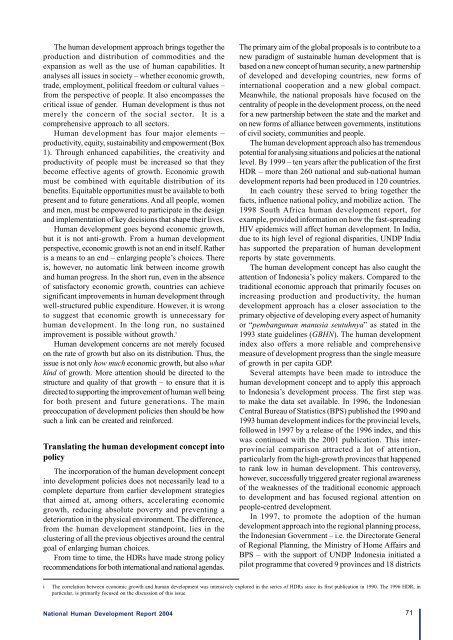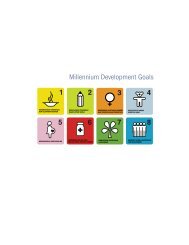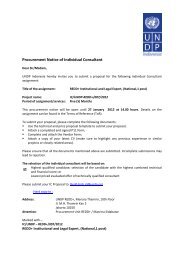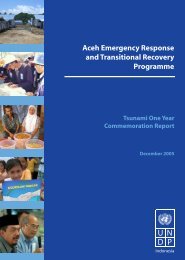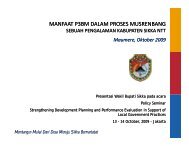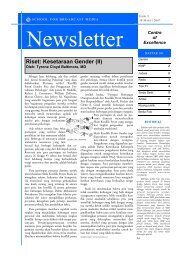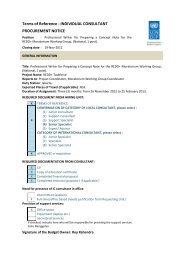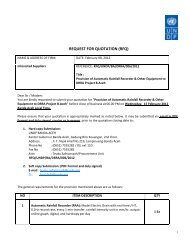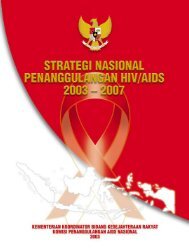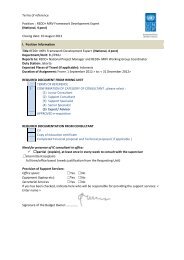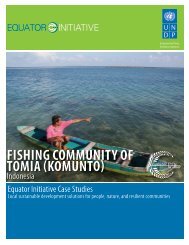The concept and measurementof human <strong>Development</strong>“People are <strong>the</strong> real wealth of a nation. The basicobjective of development is to create an enablingenvironment for people to enjoy long, healthy, and creativelives. This may appear to be a simple truth. But it isoften forgotten in <strong>the</strong> immediate concern with <strong>the</strong>accumulation of commodities and financial wealth.”Those opening lines of <strong>the</strong> first <strong>Human</strong> <strong>Development</strong><strong>Report</strong> (HDR), published by <strong>the</strong> United Nations <strong>Development</strong>Programme (<strong>UNDP</strong>) in 1990, clearly stressed <strong>the</strong> primarymessage of every HDR at global, national and sub-nationallevels – <strong>the</strong> human-centred approached to development –that places human well being as <strong>the</strong> ultimate end ofdevelopment, not <strong>the</strong> means of development. Unlike previousconcepts of development which have often given exclusiveattention to economic growth, on <strong>the</strong> assumption thatgrowth will ultimately benefit people, human developmentintroduces a broader and more comprehensive concept,covering all human choices at all societies at all stages ofdevelopment. It broadens <strong>the</strong> development dialogue from adiscussion of mere means (GNP growth) to a discussion of<strong>the</strong> ultimate ends. It draws its inspiration from <strong>the</strong> longtermgoals of a society and weaves development aroundpeople, not people around development.As defined in <strong>the</strong> first HDR of 1990, human developmentis a process of enlarging people’s choices. The most criticalof <strong>the</strong>se wide-ranging choices are to live a long and healthylife, to be educated and to have access to resources neededfor a decent standard of living. O<strong>the</strong>r important choicesinclude political freedom, guaranteed human rights andpersonal self-respect. Thus, human development concernsmore than <strong>the</strong> formation of human capabilities, such asimproved health and knowledge. It also concerns <strong>the</strong> usepeople make of <strong>the</strong>ir acquired capabilities – for leisure,productive purposes, or being active in cultural, social andpolitical affairs. <strong>Human</strong> development has to balance <strong>the</strong>seconcerns.<strong>Human</strong> development requires freedom. The objective ofincreasing people’s choices cannot be achieved withoutpeople actually being free to choose what <strong>the</strong>y want to beand how <strong>the</strong>y want to live. People must be free to exercise<strong>the</strong>ir choices in properly functioning markets, and <strong>the</strong>y musthave decisive voices in shaping <strong>the</strong>ir political frameworks.People who are politically free can ensure <strong>the</strong>ir participationin planning and decision-making through democratic rulethat leads towards consensus and consolidation ra<strong>the</strong>r thanbeing dictated to by an autocratic elite. Here, humandevelopment and human rights share a common visionand a common purpose – to secure <strong>the</strong> freedom, wellbeingand dignity of all people everywhere.To avoid any confusion, it is necessary to clearlydelineate <strong>the</strong> difference between this way of looking atdevelopment and <strong>the</strong> conventional approaches to economicgrowth, human capital formation, human resourcedevelopment, human welfare or basic needs. The conceptof human development is much broader than <strong>the</strong>conventional <strong>the</strong>ories of economic development.‘Economic growth’ models deal with expanding <strong>the</strong>GNP ra<strong>the</strong>r than with enhancing <strong>the</strong> quality of humanlives. ‘<strong>Human</strong> resource development’ treats human beingsprimarily as inputs in <strong>the</strong> production process – as meansra<strong>the</strong>r than as ends. The ‘welfare’ approach looks at humanbeings as beneficiaries and not as agents of change in <strong>the</strong>development process. Finally, <strong>the</strong> ‘basic needs’ approachfocuses on providing material goods and services todeprived population groups ra<strong>the</strong>r than on enlarging humanchoices in all fields.Box 1Four essential components of <strong>the</strong> humandevelopment paradigmThe human development paradigm contains fourmain components:• Productivity. People must be enabled to increase<strong>the</strong>ir productivity and participate fully in <strong>the</strong> processof income generation and remunerativeemployment. Economic growth is, <strong>the</strong>refore, asubset of human development models.• Equity. People must have access to equalopportunities. All barriers to economic and politicalopportunities must be eliminated so that peoplecan participate in, and benefit from, <strong>the</strong>seopportunities.• Sustainability. Access to opportunities must beensured not only for <strong>the</strong> present generations but forfuture generation as well. All forms of capital -physical, human, environmental - should bereplenished.• Empowerment. <strong>Development</strong> must be by <strong>the</strong>people, not only for <strong>the</strong>m. People must participatefully in <strong>the</strong> decisions and processes that shape <strong>the</strong>irlives.(HDR 1995, page 12)70National <strong>Human</strong> <strong>Development</strong> <strong>Report</strong> 2004
The human development approach brings toge<strong>the</strong>r <strong>the</strong>production and distribution of commodities and <strong>the</strong>expansion as well as <strong>the</strong> use of human capabilities. Itanalyses all issues in society – whe<strong>the</strong>r economic growth,trade, employment, political freedom or cultural values –from <strong>the</strong> perspective of people. It also encompasses <strong>the</strong>critical issue of gender. <strong>Human</strong> development is thus notmerely <strong>the</strong> concern of <strong>the</strong> social sector. It is acomprehensive approach to all sectors.<strong>Human</strong> development has four major elements –productivity, equity, sustainability and empowerment (Box1). Through enhanced capabilities, <strong>the</strong> creativity andproductivity of people must be increased so that <strong>the</strong>ybecome effective agents of growth. Economic growthmust be combined with equitable distribution of itsbenefits. Equitable opportunities must be available to bothpresent and to future generations. And all people, womenand men, must be empowered to participate in <strong>the</strong> designand implementation of key decisions that shape <strong>the</strong>ir lives.<strong>Human</strong> development goes beyond economic growth,but it is not anti-growth. From a human developmentperspective, economic growth is not an end in itself. Ra<strong>the</strong>ris a means to an end – enlarging people’s choices. Thereis, however, no automatic link between income growthand human progress. In <strong>the</strong> short run, even in <strong>the</strong> absenceof satisfactory economic growth, countries can achievesignificant improvements in human development throughwell-structured public expenditure. However, it is wrongto suggest that economic growth is unnecessary forhuman development. In <strong>the</strong> long run, no sustainedimprovement is possible without growth. i<strong>Human</strong> development concerns are not merely focusedon <strong>the</strong> rate of growth but also on its distribution. Thus, <strong>the</strong>issue is not only how much economic growth, but also whatkind of growth. More attention should be directed to <strong>the</strong>structure and quality of that growth – to ensure that it isdirected to supporting <strong>the</strong> improvement of human well beingfor both present and future generations. The mainpreoccupation of development policies <strong>the</strong>n should be howsuch a link can be created and reinforced.Translating <strong>the</strong> human development concept intopolicyThe incorporation of <strong>the</strong> human development conceptinto development policies does not necessarily lead to acomplete departure from earlier development strategiesthat aimed at, among o<strong>the</strong>rs, accelerating economicgrowth, reducing absolute poverty and preventing adeterioration in <strong>the</strong> physical environment. The difference,from <strong>the</strong> human development standpoint, lies in <strong>the</strong>clustering of all <strong>the</strong> previous objectives around <strong>the</strong> centralgoal of enlarging human choices.From time to time, <strong>the</strong> HDRs have made strong policyrecommendations for both international and national agendas.The primary aim of <strong>the</strong> global proposals is to contribute to anew paradigm of sustainable human development that isbased on a new concept of human security, a new partnershipof developed and developing countries, new forms ofinternational cooperation and a new global compact.Meanwhile, <strong>the</strong> national proposals have focused on <strong>the</strong>centrality of people in <strong>the</strong> development process, on <strong>the</strong> needfor a new partnership between <strong>the</strong> state and <strong>the</strong> market andon new forms of alliance between governments, institutionsof civil society, communities and people.The human development approach also has tremendouspotential for analysing situations and policies at <strong>the</strong> nationallevel. By 1999 – ten years after <strong>the</strong> publication of <strong>the</strong> firstHDR – more than 260 national and sub-national humandevelopment reports had been produced in 120 countries.In each country <strong>the</strong>se served to bring toge<strong>the</strong>r <strong>the</strong>facts, influence national policy, and mobilize action. The1998 South Africa human development report, forexample, provided information on how <strong>the</strong> fast-spreadingHIV epidemics will affect human development. In India,due to its high level of regional disparities, <strong>UNDP</strong> Indiahas supported <strong>the</strong> preparation of human developmentreports by state governments.The human development concept has also caught <strong>the</strong>attention of <strong>Indonesia</strong>’s policy makers. Compared to <strong>the</strong>traditional economic approach that primarily focuses onincreasing production and productivity, <strong>the</strong> humandevelopment approach has a closer association to <strong>the</strong>primary objective of developing every aspect of humanityor “pembangunan manusia seutuhnya” as stated in <strong>the</strong>1993 state guidelines (GBHN). The human developmentindex also offers a more reliable and comprehensivemeasure of development progress than <strong>the</strong> single measureof growth in per capita GDP.Several attempts have been made to introduce <strong>the</strong>human development concept and to apply this approachto <strong>Indonesia</strong>’s development process. The first step wasto make <strong>the</strong> data set available. In 1996, <strong>the</strong> <strong>Indonesia</strong>nCentral Bureau of Statistics (BPS) published <strong>the</strong> 1990 and1993 human development indices for <strong>the</strong> provincial levels,followed in 1997 by a release of <strong>the</strong> 1996 index, and thiswas continued with <strong>the</strong> 2001 publication. This interprovincialcomparison attracted a lot of attention,particularly from <strong>the</strong> high-growth provinces that happenedto rank low in human development. This controversy,however, successfully triggered greater regional awarenessof <strong>the</strong> weaknesses of <strong>the</strong> traditional economic approachto development and has focused regional attention onpeople-centred development.In 1997, to promote <strong>the</strong> adoption of <strong>the</strong> humandevelopment approach into <strong>the</strong> regional planning process,<strong>the</strong> <strong>Indonesia</strong>n Government – i.e. <strong>the</strong> Directorate Generalof Regional Planning, <strong>the</strong> Ministry of Home Affairs andBPS – with <strong>the</strong> support of <strong>UNDP</strong> <strong>Indonesia</strong> initiated apilot programme that covered 9 provinces and 18 districtsiThe correlation between economic growth and human development was intensively explored in <strong>the</strong> series of HDRs since its first publication in 1990. The 1996 HDR, inparticular, is primarily focused on <strong>the</strong> discussion of this issueNational <strong>Human</strong> <strong>Development</strong> <strong>Report</strong> 2004 71
- Page 2 and 3:
NationalHuman DevelopmentReport 200
- Page 4 and 5:
ForewordIndonesia has made critical
- Page 6 and 7:
AcknowledgementsThis Report is a re
- Page 8:
AbbreviationsAPBDAPBNASEANBAPPENASB
- Page 11 and 12:
TABLES2.1 - Comparison of per capit
- Page 13 and 14:
EXECUTIVE SUMMARYIndonesiaNational
- Page 15 and 16:
to meet the Millennium Development
- Page 17 and 18:
Chapter 1Indonesia in transition:To
- Page 19 and 20:
The place of human development in I
- Page 21 and 22:
Chapter 2The state of human develop
- Page 23 and 24:
Figure 2.4 - Map of human developme
- Page 25 and 26:
Figure 2.4 - Social indicators, 197
- Page 27 and 28:
of income and corporate taxes has r
- Page 29 and 30:
Figure 2.10 - GDP growth, 1990-2003
- Page 31 and 32: Table 2.4 - Proportion of total bri
- Page 33 and 34: In addition, the overall sense of p
- Page 35 and 36: themselves. On this basis Indonesia
- Page 37 and 38: Box 3.2 - Pathways to human develop
- Page 39 and 40: Table 3.3 - Infant mortality rate a
- Page 41 and 42: poor is a clear recognition that de
- Page 43 and 44: educing the infant mortality rate m
- Page 45 and 46: assuming that 1.3 trillion would co
- Page 47 and 48: The national figure would certainly
- Page 49 and 50: expenditure. In practice, it would
- Page 51 and 52: Table 4.2 - Provincial breakdown of
- Page 53 and 54: administration, plus an allowance f
- Page 55 and 56: Figure 4.5 - Ratio of salaries of p
- Page 57 and 58: Appendix to Chapter 4Health and edu
- Page 59 and 60: The third is the ‘Special Fund’
- Page 61 and 62: Chapter 5Rethinking fiscal prioriti
- Page 63 and 64: At the very outset, however, it sho
- Page 65 and 66: enforcement particularly for person
- Page 67 and 68: Another risk from decentralization
- Page 69 and 70: Box 5.2 - Variations in poverty con
- Page 71 and 72: physical security - which contribut
- Page 73 and 74: centre, for example, played a signi
- Page 75 and 76: BibliographyAbidin, A. (2002), 1 st
- Page 77 and 78: LPEM-FEUI (2004), Draft Final Repor
- Page 79 and 80: Subbarao, K., A. Bonnerjee, J. Brai
- Page 81: HUMAN DEVELOPMENT INDICATORS AND IN
- Page 85 and 86: Box 2HDI, HPI-1, GDI and GEMHuman D
- Page 87 and 88: What do the human developmentindice
- Page 89 and 90: Table 1 - Districts making the grea
- Page 91 and 92: Table 2 - Districts with the highes
- Page 93 and 94: Figure 8 - GDI by province, 1999-20
- Page 95 and 96: Figure 12 - HPI by components, 1999
- Page 97 and 98: Technical workshopon human developm
- Page 99 and 100: • The percentage of households wi
- Page 101 and 102: 11 Percentage of people with self-t
- Page 103 and 104: Annex 2N a m esGROUP IIChairperson:
- Page 105 and 106: Changes in names due to the formati
- Page 107 and 108: LampungKab. Lampung Selatan (South
- Page 109 and 110: 1Human Development Index (HDI)by pr
- Page 111 and 112: 3Gender-related Development Index (
- Page 113 and 114: 5Human Poverty Index (HPI)by provin
- Page 115 and 116: ProvinceDistrictLiveexpectancy(year
- Page 117 and 118: ProvinceDistrictLiveexpectancy(year
- Page 119 and 120: ProvinceDistrictLiveexpectancy(year
- Page 121 and 122: ProvinceDistrictLiveexpectancy(year
- Page 123 and 124: ProvinceDistrictLife expectancy(yea
- Page 125 and 126: ProvinceDistrictLife expectancy(yea
- Page 127 and 128: ProvinceDistrictLife expectancy(yea
- Page 129 and 130: 8Gender Development Index (GDI)by d
- Page 131 and 132: ProvinceDistrictProportionof popula
- Page 133 and 134:
ProvinceDistrictProportionof popula
- Page 135 and 136:
ProvinceDistrictProportionof popula
- Page 137 and 138:
9Gender Empowerment Measure (GEM)by
- Page 139 and 140:
ProvinceDistrictParticipationof wom
- Page 141 and 142:
ProvinceKabupaten/KotaDistrictParti
- Page 143 and 144:
ProvinceKabupaten/KotaDistrictParti
- Page 145 and 146:
ProvinceDistrictParticipationof wom
- Page 147 and 148:
ProvinceDistrictParticipationof wom
- Page 149 and 150:
ProvinceDistrictParticipationof wom
- Page 151 and 152:
ProvinceDistrictParticipationof wom
- Page 153 and 154:
ProvinceDistrictPeople notexpected
- Page 155 and 156:
ProvinceDistrictPeople notexpected
- Page 157 and 158:
ProvinceDistrictPeople notexpected
- Page 159 and 160:
ProvinceDistrictPeople notexpected
- Page 161 and 162:
ProvinceDistrictInfantmortalityrate
- Page 163 and 164:
ProvinceDistrictInfantmortalityrate
- Page 165 and 166:
ProvinceDistrictInfantmortalityrate
- Page 167 and 168:
ProvinceDistrictInfantmortalityrate
- Page 169 and 170:
ProvinceDistrictSchool Participatio
- Page 171 and 172:
ProvinceDistrictSchool Participatio
- Page 173 and 174:
ProvinceDistrictSchool Participatio
- Page 175 and 176:
ProvinceDistrictSchool Participatio
- Page 177 and 178:
ProvinceDistrictHouseholds withacce
- Page 179 and 180:
ProvinceDistrictHouseholds withacce
- Page 181 and 182:
ProvinceDistrictHouseholds withacce
- Page 183 and 184:
ProvinceDistrictHouseholds withacce
- Page 185 and 186:
ProvinceDistrictReal per capita GRD
- Page 187 and 188:
ProvinceDistrictReal per capita GRD
- Page 189 and 190:
ProvinceDistrictReal per capita GRD
- Page 191 and 192:
ProvinceDistrictReal per capita GRD
- Page 193 and 194:
ProvinceDistrictLabourforceparticip
- Page 195 and 196:
ProvinceDistrictLabourforceparticip
- Page 197 and 198:
ProvinceDistrictLabourforceparticip
- Page 199 and 200:
ProvinceDistrictLabourforceparticip
- Page 201 and 202:
ProvinceDistrictDevelopmentexpendit
- Page 203 and 204:
ProvinceDistrictDevelopmentexpendit
- Page 205 and 206:
ProvinceDistrictDevelopmentexpendit
- Page 207 and 208:
ProvinceDistrictDevelopmentexpendit
- Page 209 and 210:
Computing the indicesThe Human Deve
- Page 211 and 212:
Calculating the HDIThis illustratio
- Page 213 and 214:
Calculating the GDIAs an example, t
- Page 215 and 216:
Definitions of Statistical TermsAcc
- Page 217:
School drop-out rate: the proportio


